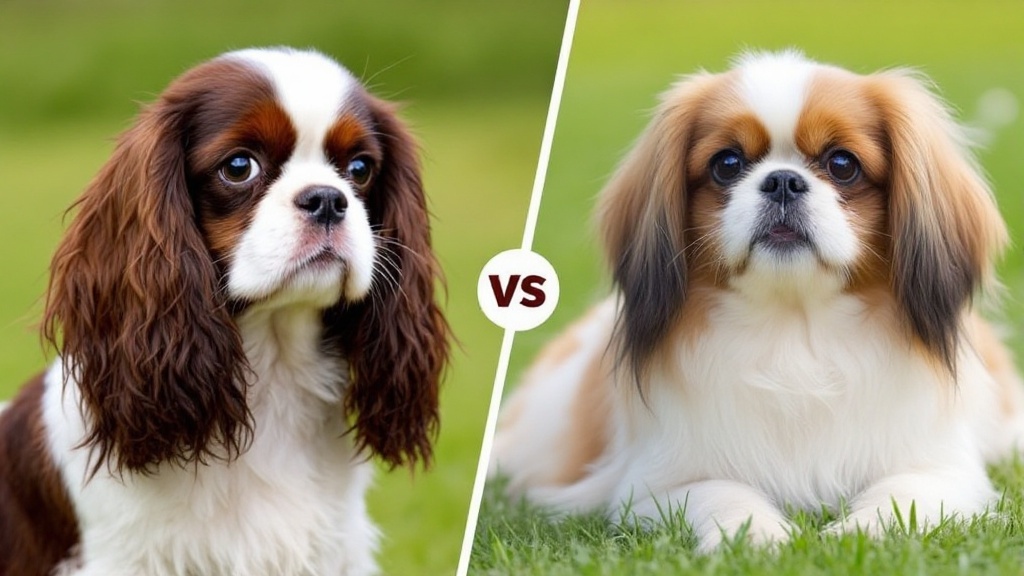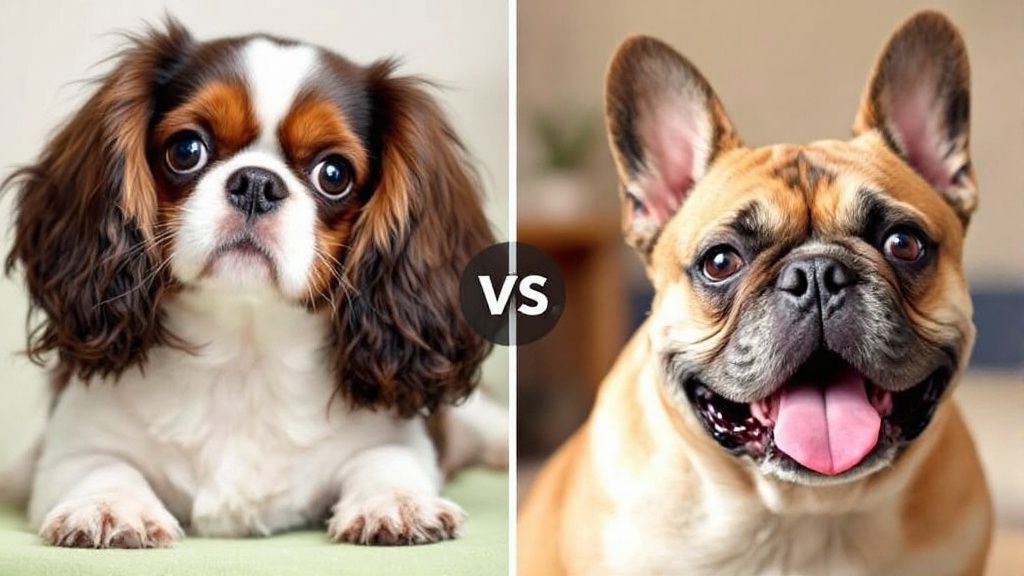Choosing between a Cavalier King Charles Spaniel and a Pekingese isn’t easy—both are small, charming breeds with personalities that really stand out.
The Cavalier King Charles Spaniel is famously friendly and gentle, while the Pekingese brings a bold, loyal vibe to the table.

You might be after a dog that’s great with kids, simple to groom, or one that thrives in an apartment.
Knowing how these breeds differ—and where they overlap—can help you figure out which one will actually fit your life.
Let’s dig into their personalities, health quirks, looks, and energy, so you’ll know what you’re signing up for with either breed.
Breed Origins and History
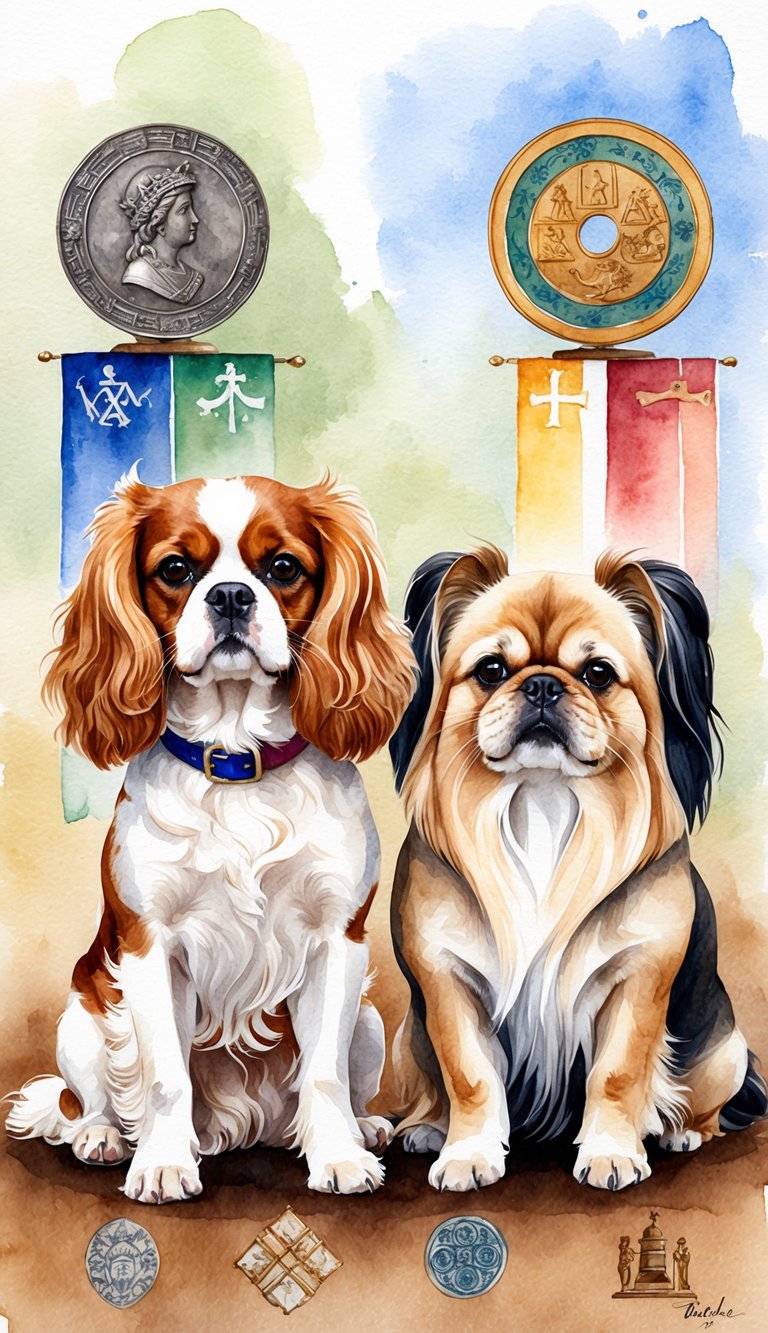
Cavalier King Charles Spaniels and Pekingese come from totally different places and backgrounds.
Their histories explain a lot about their looks and quirks.
History of the Cavalier King Charles Spaniel
The Cavalier King Charles Spaniel got its start in England.
Royalty, especially King Charles II, adored these dogs—hence the name.
Early Cavaliers lounged in royal courts as lapdogs and hung out with noble families in the 1600s and 1700s.
They belong to the spaniel family.
At some point, breeders mixed them with smaller dogs, creating short-nosed English Toy Spaniels.
In the 1920s, people wanted the old, longer-nosed look back.
That kicked off the breeding that led to today’s Cavalier King Charles Spaniel.
The Kennel Club (UK) officially recognized the breed in 1945.
Now, you’ll find Cavaliers everywhere, loved for their sweet and gentle personalities.
Pekingese Heritage and Background
Pekingese hail from ancient China.
For centuries, only Chinese royalty could own them, and stealing one was a big deal—a crime, even.
They have a flat face, loads of fur, and a compact, sturdy body.
People often call them a classic brachycephalic breed.
Their lion-like mane and small size made them a symbol of prestige and protection in Chinese palaces.
British troops brought the first Pekingese to England in the mid-1800s.
Since then, they’ve been a favorite toy breed in all sorts of places.
Key Developments in Dog Breeding
Royalty and the upper class shaped both breeds through selective breeding.
In England, breeders changed the Cavalier’s nose and skull shape, setting them apart from the English Toy Spaniel.
Pekingese breeders focused on keeping that flat face and lion-dog look.
Both breeds ended up with some common health issues—heart problems for Cavaliers, breathing issues for Pekingese.
Modern breeding tries to balance looks and health, though old traditions still influence how these dogs are bred and judged.
Responsible breeders work to cut down on inherited problems and keep those signature traits.
Physical Characteristics
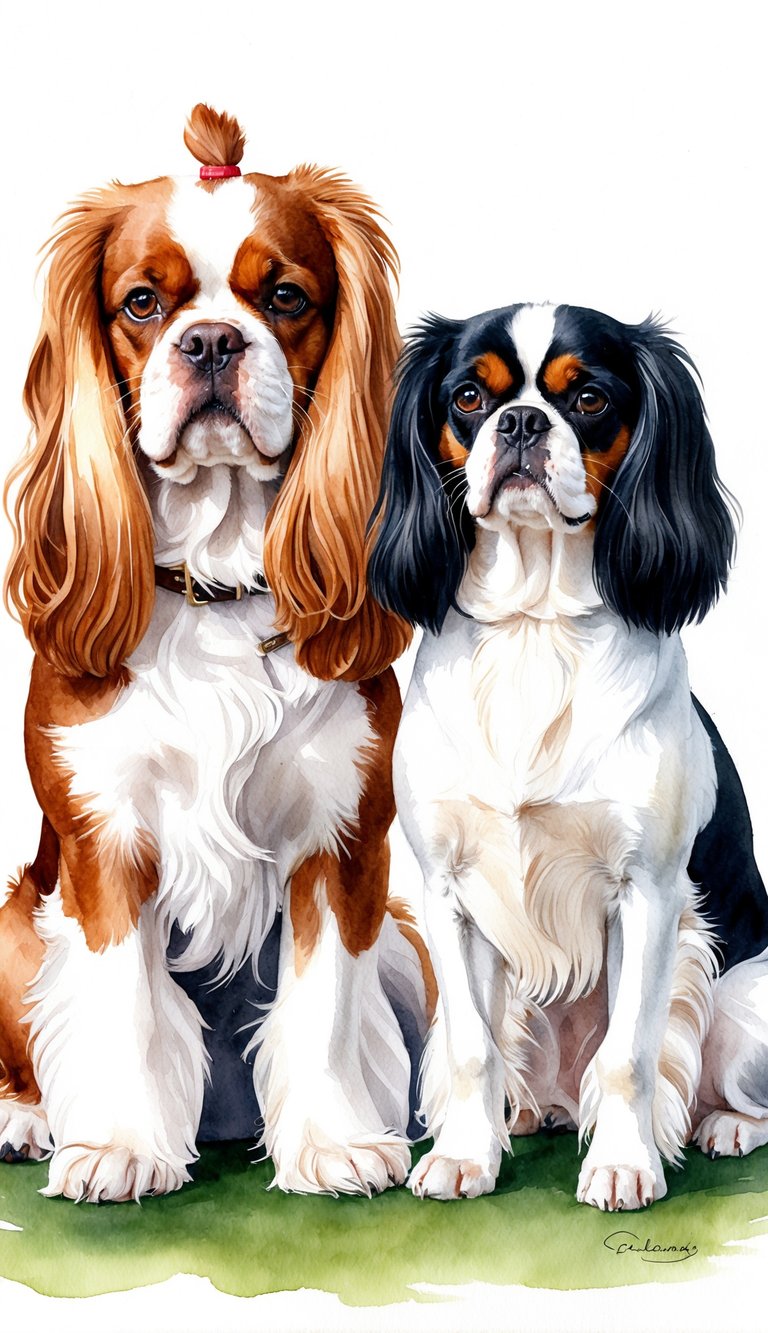
Both breeds are small, but you’ll spot differences right away.
Their size, coats, and features make them easy to tell apart.
Size and Weight Comparison
Cavalier King Charles Spaniels stand a bit taller and longer than Pekingese.
Cavaliers usually weigh 13 to 18 pounds and reach 12 to 13 inches at the shoulder.
Pekingese are lighter and shorter, weighing 7 to 14 pounds and standing 6 to 9 inches tall.
Despite their differences, both are toy breeds and do well in apartments.
Table: Size Comparison
| Breed | Height (inches) | Weight (pounds) |
|---|---|---|
| Cavalier King Charles Spaniel | 12–13 | 13–18 |
| Pekingese | 6–9 | 7–14 |
Coat Types and Colors
Cavaliers have silky, medium-length coats that can be straight or a little wavy.
Their fur feathers out on the ears, chest, legs, and tail.
They come in four main colors: Blenheim (chestnut and white), Tricolor (black, white, and tan), Ruby (solid red), and Black & Tan.
Pekingese, on the other hand, sport a thick, long double coat.
The outer layer is straight and rough, while the undercoat feels softer.
Their mane around the neck gives them that classic lion-dog look.
Pekingese can be just about any color—gold, sable, cream, black, white, brindle, you name it.
You’ll need to groom them often to keep that fur under control.
Distinctive Features
The Cavalier’s face is sweet and rounded, with big, dark, expressive eyes.
Their long, feathered ears sit high on the head.
They’ve got a graceful, balanced build and a soft, gentle expression.
Pekingese have a flat nose, wide wrinkled face, and big, prominent eyes.
Their bodies are short and broad, and their tails curl over their backs.
That mane really makes them look regal.
These features are adorable but also mean you’ll need to pay attention to their care and health.
Temperament and Personality Traits
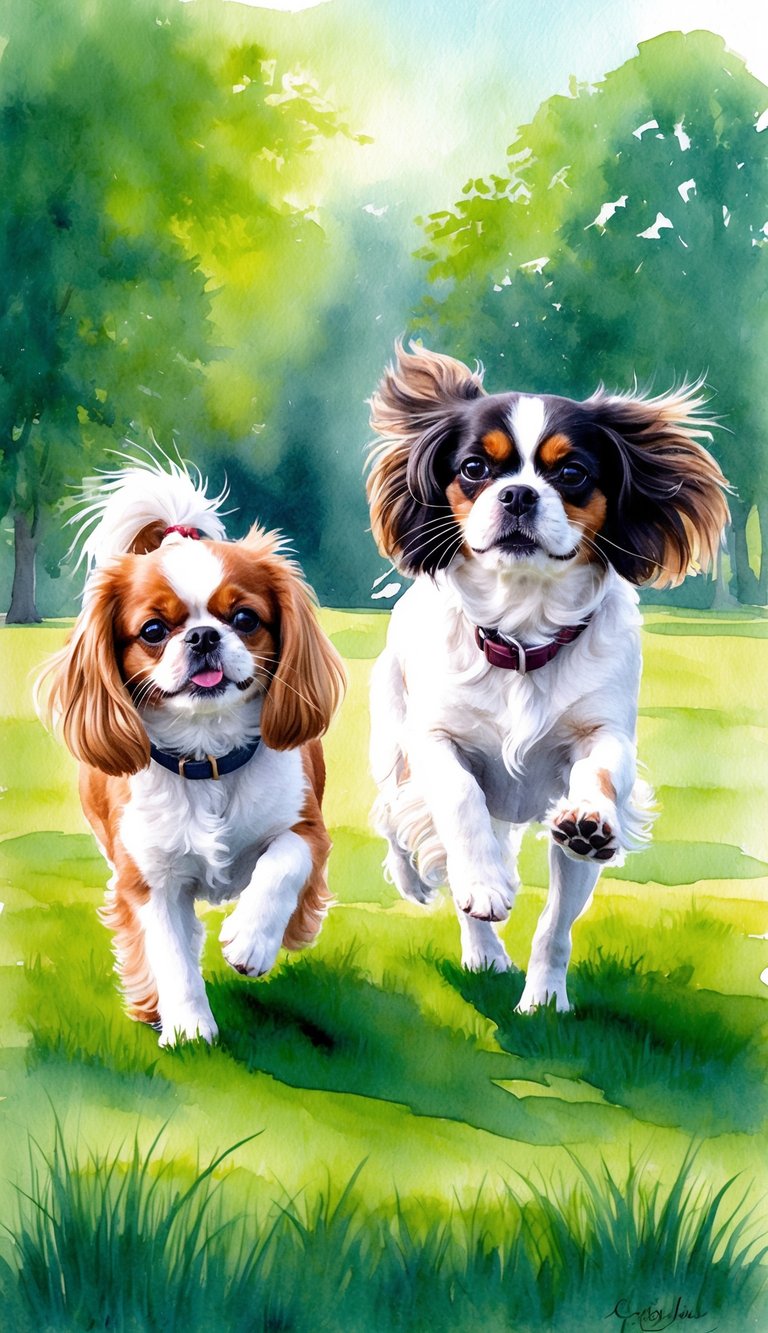
Cavaliers and Pekingese are both beloved companion dogs, but their personalities can be worlds apart.
Getting a feel for these quirks can help you pick the breed that fits your vibe, family, and home.
Behavior with Families and Children
Cavalier King Charles Spaniels tend to be gentle and affectionate.
They love hanging out with people, including kids, and usually bond closely with their families.
Cavaliers are patient and handle gentle play from children pretty well.
Pekingese lean more independent and can be reserved.
They’ll show love to their people, but they’re less likely to enjoy rough or loud kids.
Pekingese might do best in calmer homes and may keep their distance from strangers.
If you’ve got young kids, Cavaliers are probably the safer bet for a playful, adaptable friend.
Pekingese can be great too, if everyone in the house knows how to respect their space.
Interaction with Other Pets
Cavaliers usually get along with other dogs and even cats.
Their easygoing attitude means they rarely start trouble.
They tend to fit into multi-pet homes without much drama.
Pekingese are pickier about their animal friends.
Some warm up to other pets, but others get territorial.
Early socialization helps, but they generally get along best with pets they’ve known since puppyhood.
Compared to social breeds like toy poodles, Pekingese can seem a bit standoffish.
Both breeds need slow, careful introductions with new animals in the house.
Intelligence and Trainability
Cavaliers are smart and eager to please.
They pick up training quickly, especially if treats or praise are involved.
They’re a bit like toy poodles in that way—always up for a game or learning something new.
Pekingese are clever too, but they can be stubborn.
Their independent streak means they’ll sometimes ignore you unless they feel like cooperating.
Gentle, consistent training works best for them.
You’ll need a little more patience than you would with a Cavalier, honestly.
Both breeds benefit from early training and socialization.
Typical Activity Levels
Cavaliers have a moderate energy level.
They enjoy daily walks and playtime but also love just chilling out with you.
They’ll adapt to your lifestyle as long as they get attention and a bit of exercise.
Pekingese are more laid-back.
Short walks and some indoor play usually keep them happy.
Their flat faces mean they tire out quickly, especially if it’s hot or humid.
If you want a buddy for outdoor adventures, Cavaliers are probably more up your alley.
Pekingese thrive with a calm, indoor routine.
Both breeds adore their people, but they show it in their own ways.
Health Considerations

Cavalier King Charles Spaniels and Pekingese each come with their own health risks.
Their lifespans, care needs, and common issues are shaped by their breed quirks and body shapes.
Common Health Issues
Cavaliers are prone to heart conditions, especially mitral valve disease, which can show up pretty early.
They’re also at risk for syringomyelia, a problem with fluid around the brain and spine.
Other issues include hip dysplasia, eye troubles, and ear infections—those floppy ears can be a pain sometimes.
Pekingese have health problems tied to their short noses and flat faces.
They can struggle to breathe, especially in heat or when stressed.
Eye injuries, back problems, and skin fold infections also pop up.
Both breeds need regular vet checkups to catch issues early.
Quick comparison table:
| Breed | Key Concerns |
|---|---|
| Cavalier King Charles Spaniel | Heart disease, syringomyelia, eye/ear issues |
| Pekingese | Breathing, eye, skin, back problems |
Lifespan and Longevity
Cavaliers usually live about 9 to 14 years.
Some face serious health problems early, especially heart or brain issues.
Pekingese often live 12 to 15 years.
Breathing and back troubles can shorten their lives if not managed well.
Regular vet visits, healthy diets, and keeping your dog at a good weight can make a big difference.
There are plenty of apps and resources to help you track appointments and spot early warning signs.
Special Care Requirements
Cavaliers need their ears checked and cleaned often to avoid infections.
They do well with moderate exercise but need watching for shortness of breath or heart stress.
If they develop syringomyelia or joint issues, you’ll want to be careful with stairs.
Pekingese need daily facial cleaning—their wrinkles can trap dirt and moisture, causing skin problems.
Because of their airways, they should avoid heat and rough play.
Always use a harness instead of a collar, since their tracheas are delicate.
Vet-approved guides, websites, and apps can help with breed-specific tips.
Regular grooming, good weight control, and keeping an eye on their breathing or movement will go a long way for both breeds.
Grooming and Maintenance
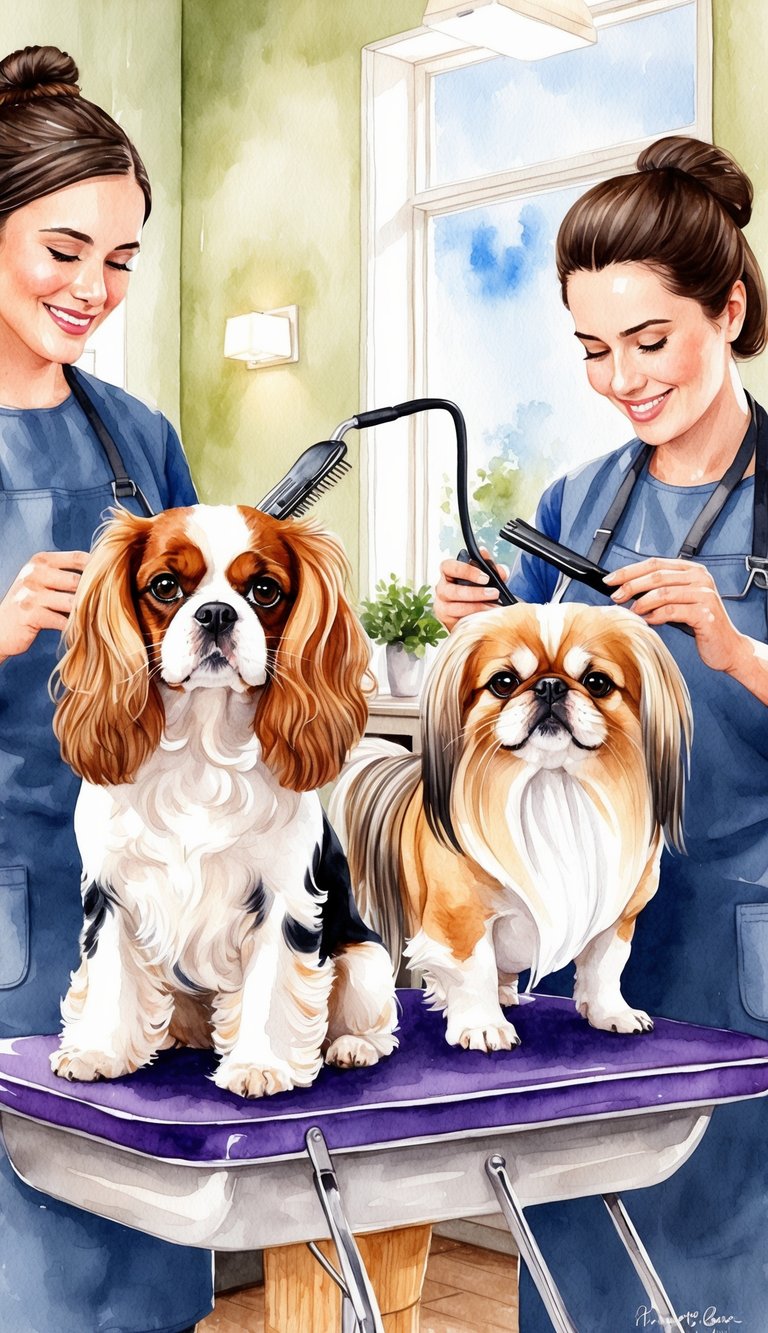
Both the Cavalier King Charles Spaniel and the Pekingese need regular grooming, but their coats make those routines pretty different. Your grooming routine will affect your schedule—and honestly, maybe your allergy concerns too.
Coat Care Needs
The Cavalier King Charles Spaniel has a silky, medium-length coat. You’ll want to brush them at least three or four times a week.
This keeps tangles away, especially behind the ears and around the legs. Baths every four to six weeks help keep that coat clean and shiny.
The Pekingese? Their thick double coat and heavy mane are a whole other story. Daily brushing really is best, mostly to deal with mats in the dense fur around the neck and rear.
A metal comb and a pin brush are your friends here. Sometimes, you’ll need to trim the hair around the eyes and paws to keep things neat.
A trip to a professional groomer every month or two helps keep their coat in shape.
Shedding and Allergen Concerns
Cavalier King Charles Spaniels shed moderately all year. Fur tends to collect on floors and furniture, so you’ll probably want to vacuum often.
They aren’t hypoallergenic, but some folks with mild allergies find them manageable if you stay on top of grooming.
The Pekingese sheds more, especially when the seasons change. Their undercoat comes out in clumps during spring and fall.
Daily brushing helps keep fur tumbleweeds at bay. Neither breed is low-allergen, and people with strong allergies might find the Pekingese’s shedding a bit much.
Air filters and frequent cleaning can help with dander, but there’s no magic fix here.
Exercise and Activity Requirements
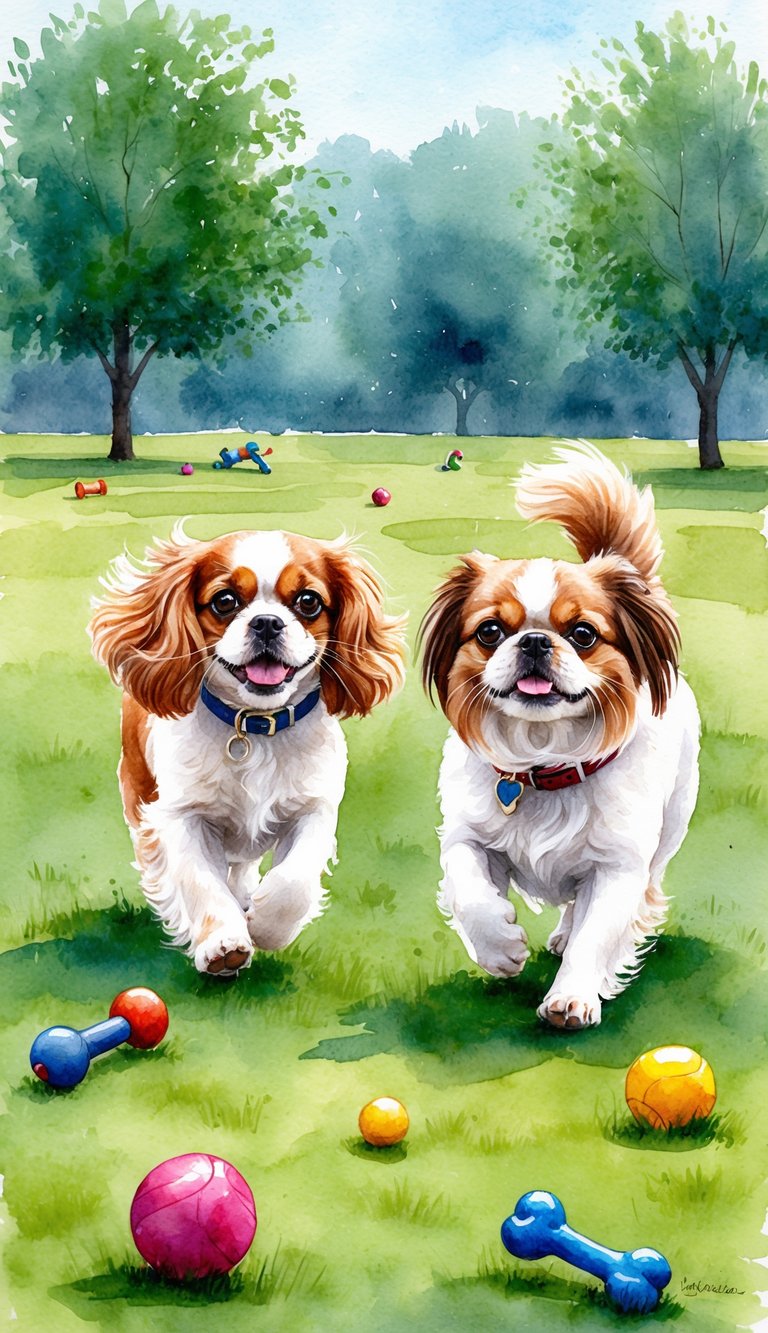
Both breeds need regular activity, but their energy and routines aren’t quite the same. Keeping them healthy means thinking about their minds as much as their bodies.
Daily Exercise Routines
Cavalier King Charles Spaniels have moderate energy and like daily walks. Aim for about 30 to 60 minutes of exercise a day.
This might mean two quick walks or a play session in the yard. They’re usually up for fetch or even a gentle hike.
Pekingese, on the other hand, don’t need much exercise. Short walks and a bit of indoor play—maybe 15 to 30 minutes daily—are usually enough.
Don’t push them too hard, especially in hot weather. Their short noses make breathing tough if they get overheated.
If you’re looking for a running or hiking partner, these breeds aren’t really built for that.
Mental Stimulation Needs
Mental activity matters just as much as physical exercise for these two. Cavaliers love puzzle toys, hide-and-seek, and interactive games.
They respond well to training sessions that use treats and praise. Keeps them sharp and happy.
Pekingese prefer slower-paced games. Soft toys or simple puzzles usually keep them interested.
A few short training sessions each week help prevent boredom.
Some breeds, like Dachshunds or Miniature Schnauzers, crave more challenge and variety. Cavaliers and Pekingese are pretty content with routine and gentle attention.
Rotate toys and spend a little one-on-one time with your dog every day. That’s usually enough to keep them engaged.
Living Environment Suitability
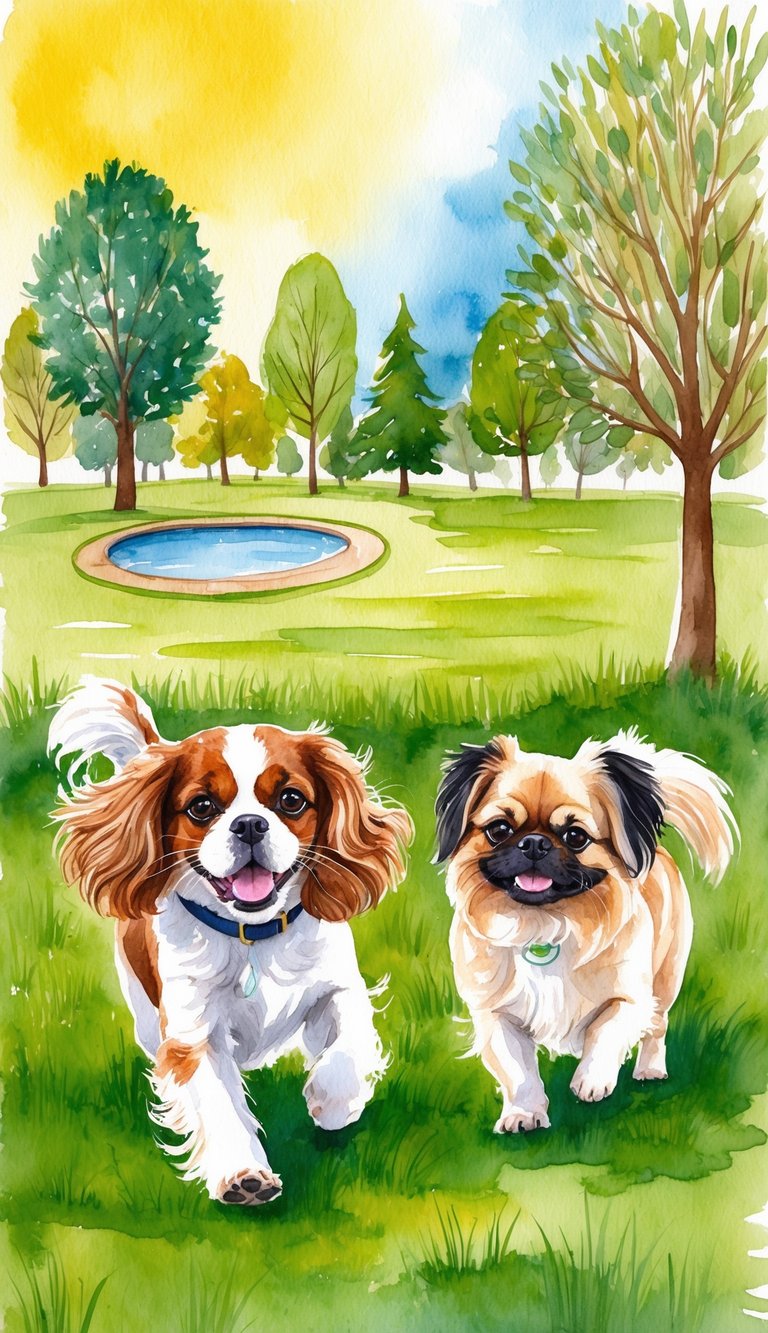
Both breeds can do well in smaller homes. But each one handles indoor life and changes in temperature a bit differently, so you’ll want to think about your living situation.
Adaptability to Apartment Living
Cavalier King Charles Spaniels are famously friendly and calm. They adapt well to apartment life.
They like being close to their people and don’t need a big yard. Daily walks and indoor play usually cover their exercise needs.
Pekingese also manage fine in apartments thanks to their small size and low energy. They’re happy with short walks and lots of lounging.
But Pekingese can be more independent and sometimes less eager to please. They’ll bark to let you know if someone’s at the door, which could be a noise issue in shared buildings.
Other toy breeds like Shih Tzu and French Bulldog are also popular for apartments. Cavaliers rarely bark for no reason, while Pekingese might be more vocal.
It’s worth thinking about how much noise and social interaction you want from your dog.
Compatibility with Various Climates
Cavaliers have a silky, medium-length coat. They can handle mild cold if you give them a warm bed and don’t leave them out too long in winter.
Hot weather can make them uncomfortable. Keep them cool, make sure they have water, and skip midday walks during the summer.
Pekingese have a thick double coat and a flat face, making hot, humid weather tough for them. Overheating is a real risk since their snub noses make breathing harder in the heat.
Air conditioning, shade, and regular grooming are pretty important in warm months. Pekingese do better indoors year-round.
Their coat helps in cold weather, but they still need a warm place and shouldn’t stay outside for long.
Pick a breed that fits your local climate, and be ready to adjust routines when the temperature swings. Fans, sweaters, or cooling mats can make a big difference.
Comparison with Other Companion Dog Breeds
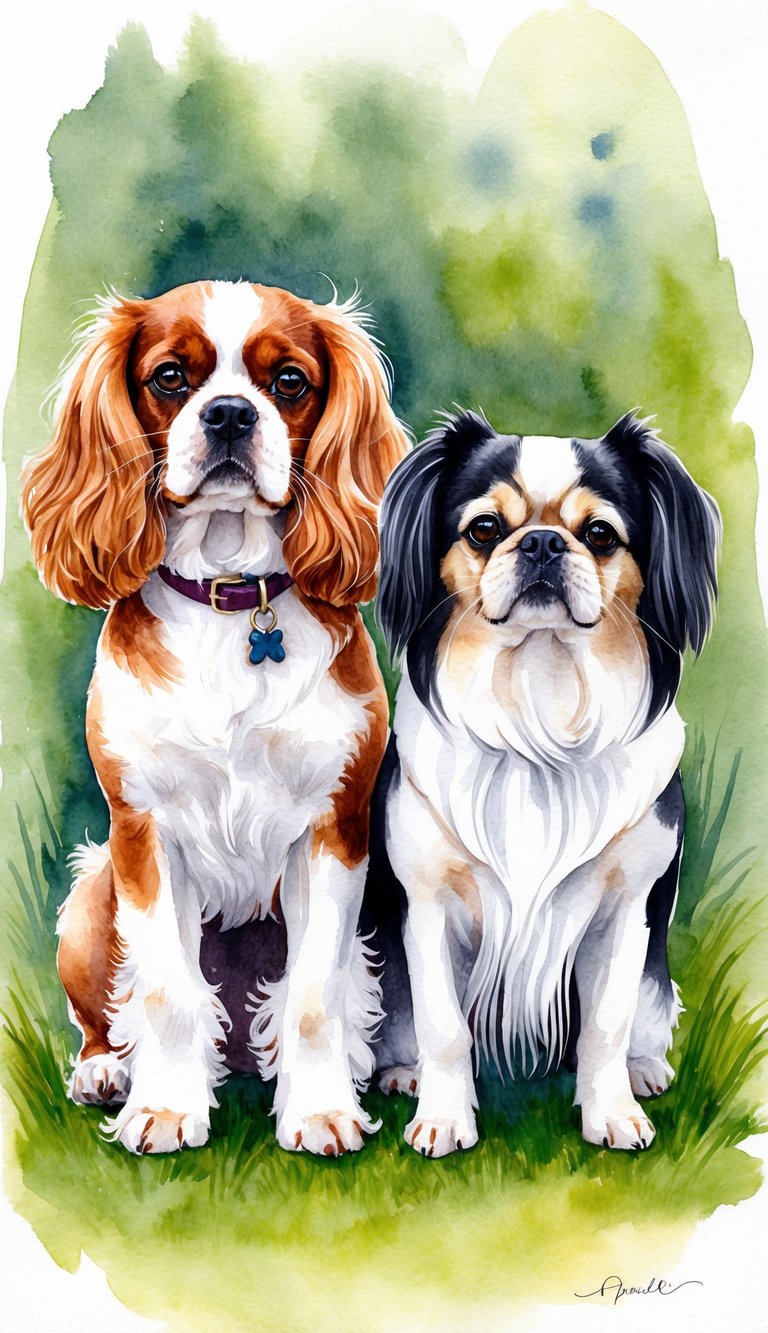
These two breeds share some traits with other small companion dogs, but there are clear differences in looks, temperament, and needs. If you’re deciding between small breeds, it’s worth digging into these details.
Toy Breed Comparisons
If you compare Cavaliers and Pekingese to other toy breeds, you’ll see they overlap in size with the Pug, Chihuahua, Toy Poodle, and Yorkshire Terrier.
Cavaliers are usually more playful and get along well with kids and other pets. Pekingese tend to be more independent and can come off as aloof.
The Shih Tzu and Lhasa Apso have similar grooming needs to the Pekingese, since all have long, flowing coats that need daily brushing. Breeds like the French Bulldog or Italian Greyhound have short fur and don’t need as much grooming.
Here’s a quick comparison table:
| Breed | Coat Type | Temperament | Shedding |
|---|---|---|---|
| Cavalier King Charles | Silky, long | Gentle, social | Moderate |
| Pekingese | Long, thick | Loyal, stubborn | Moderate-high |
| Chihuahua | Short/long | Alert, bold | Low-moderate |
| Shih Tzu | Long, dense | Playful, sweet | Low |
| French Bulldog | Short, smooth | Affectionate | Moderate |
Similarities and Differences with Spaniels
Cavalier King Charles Spaniels are close to other spaniel breeds, like the English Toy Spaniel. Spaniels are usually affectionate and eager to please.
Pekingese, though, are from East Asia and were bred for royalty. They’re not really like spaniels at all.
Beagles and Cocker Spaniels are a bit bigger and more active than Cavaliers. Cavaliers and English Toy Spaniels are more relaxed than those working spaniels.
Pekingese don’t have that classic “spaniel” friendliness. If you want a dog that’s always happy to meet people, a spaniel is probably a better bet than a Pekingese.
Crossbred and Mixed Breed Considerations
Crossbreeds like the Pekingese and Shih Tzu mix (Pekeshiht) or the Cavalier and Poodle (Cavapoo) often blend traits from both parents. A Cavapoo might have the Cavalier’s sweet nature and the Poodle’s intelligence and hypoallergenic coat.
Mixed breeds sometimes end up healthier than purebreds, but they’re less predictable in size, looks, or personality. Bull Terrier mixes or American Eskimo Dog crosses are less common but can be fun surprises.
Before picking a crossbred dog, think about the grooming, exercise, and temperament you’re likely to get. Sometimes crossbreeds are a great option if you want to avoid certain genetic issues.
Choosing the Right Breed for You
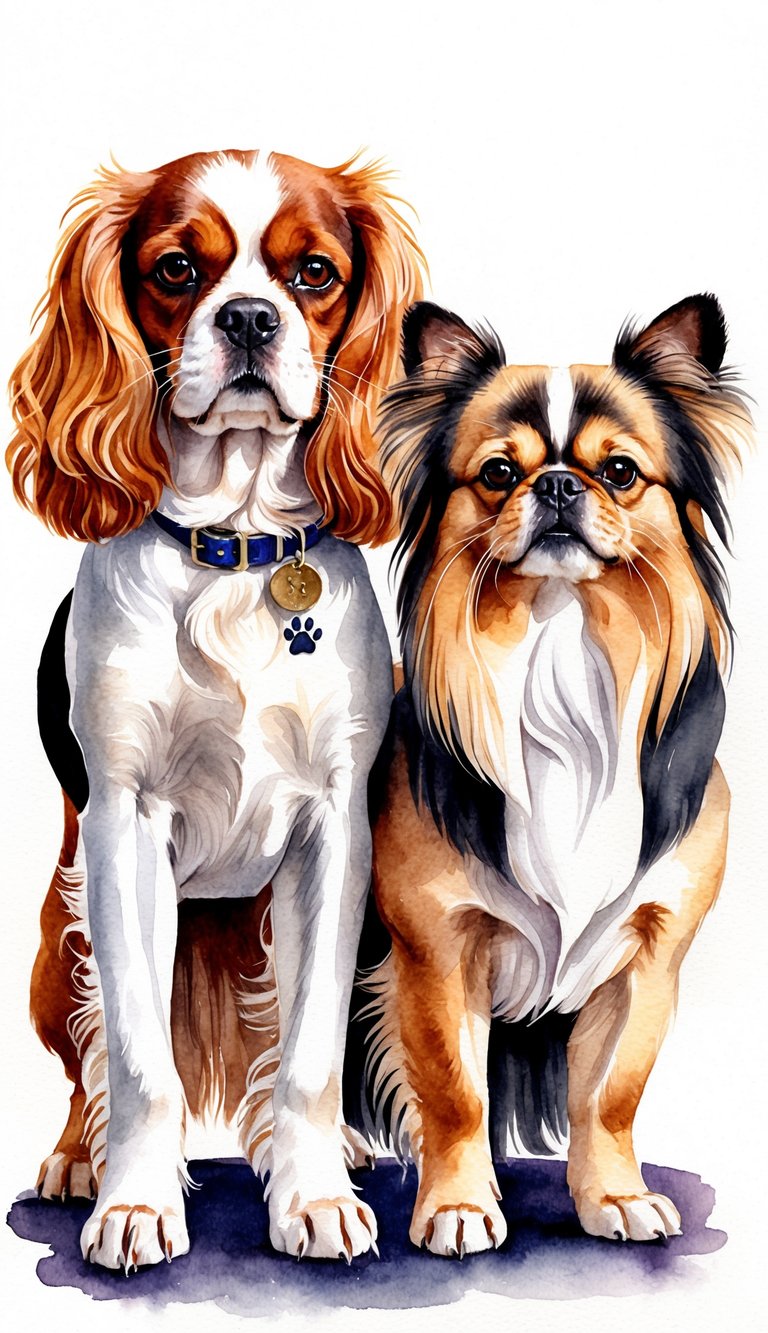
Both the Cavalier King Charles Spaniel and the Pekingese are popular companion breeds, but their needs and personalities can be pretty different. Finding the right fit for your life, your home, and your budget makes a big difference.
Lifestyle and Household Factors
Your daily routine and home setup matter a lot when picking a dog. Cavaliers are active and love being part of the family.
They’re up for walks, yard play, and joining in whatever you’re doing. Pekingese are less active and enjoy short walks and spending most of their time indoors.
If you’re in a small apartment or don’t have a yard, Pekingese will probably adapt more easily. Families with young kids often like Cavaliers for their gentle nature.
Pekingese can be more independent and might suit homes without little kids. If allergies are a concern, both breeds shed, but the Cavalier’s longer fur might mean more cleaning.
Financial Considerations
Costs to keep in mind:
- Food
- Grooming
- Vet visits
- Emergencies
Cavaliers may rack up a bit more in grooming bills because of their long coat, and regular trips to a pro groomer every few months are common. Pekingese also need consistent grooming, thanks to their thick fur and flat faces (which can mean more skin issues).
Both breeds have some health concerns. Cavaliers often deal with heart problems, while Pekingese can have breathing issues because of their short noses.
Budget for regular check-ups and possible treatments. Monthly costs for food and supplies add up, and pet insurance or vet apps like Pawp or Figo can help you plan for emergencies.
Honestly, it pays to be prepared.
Resources for New Owners
There are a ton of resources out there for anyone caring for a Cavalier King Charles Spaniel or Pekingese. Breed-specific clubs and online forums—like the Cavalier King Charles Spaniel Club USA or the Pekingese Club of America—offer advice and a sense of community.
Websites such as the American Kennel Club have tips, while pet care apps like PetDesk let you track your pup’s health and set vet reminders. If you need to find a local vet, directories like Vetstreet come in handy.
For training help, you might want to try basic obedience classes at a nearby pet store. Or maybe just download an app like Pupford and start there.
Honestly, having all these tools around makes caring for your new dog way less overwhelming. Isn’t it nice to have some backup?

